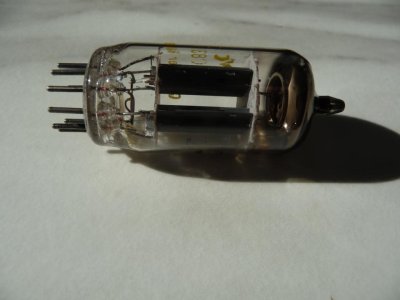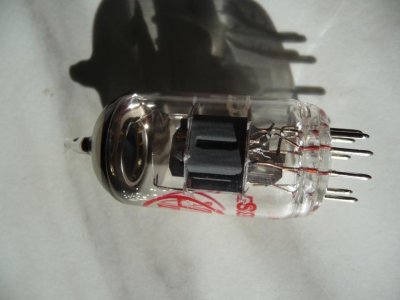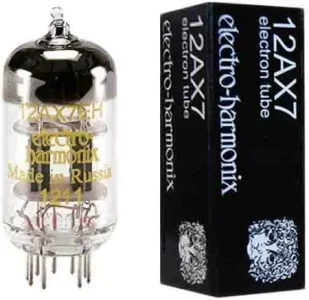In the attachments You can see two ECC83's one has shorter plates and is more built up ( in this case a JJ ECC83S) , the other has longer plates and more space in between. (it's Chelmer but similar to EH)How does that affect gain, background hum etc ?
You are using an out of date browser. It may not display this or other websites correctly.
You should upgrade or use an alternative browser.
You should upgrade or use an alternative browser.
Same tube type, different internals....
- Thread starter Gold star
- Start date
beaubrummels
Well-known member
It shouldn't affect anything - if it's a particular model, then it's manufactured to certain performance specs. But the way to know for sure is read the spec sheet on each tube to see if the manufacturer did anything different. In this case, the specs look identical (can't find "Chelmer", likely just a rebrand of something else, but EHX says...).
https://www.jj-electronic.com/images/stories/product/preamplifying_tubes/pdf/ecc83s.pdf
https://shop.ehx.com/catalog/tubes-specs/ps-ECC83.pdf
https://www.jj-electronic.com/images/stories/product/preamplifying_tubes/pdf/ecc83s.pdf
https://shop.ehx.com/catalog/tubes-specs/ps-ECC83.pdf
beaubrummels
Well-known member
Large plates are also more microphonic, but tend to sound a touch smoother IME.
misterwhizzy
Well-known member
As a general rule, I like how long-plate 12AX7s sound, but they’re completely interchangeable electrically.
Both should have a gain factor of 100.
Its the tone & how it sounds.
IMO JJ are utter sh*t.
I recently replaced my 2 JJ ECC83 S pre amp tubes after 3 years ,with Electro harmonix long plate tubes that I had stored for some time. Slightly less hum when turning up the gain but not much.. there's always a certain amount of noise with tube amps you cant get rid of ..
It shouldn't affect anything - if it's a particular model, then it's manufactured to certain performance specs. But the way to know for sure is read the spec sheet on each tube to see if the manufacturer did anything different. In this case, the specs look identical (can't find "Chelmer", likely just a rebrand of something else, but EHX says...).
https://www.jj-electronic.com/images/stories/product/preamplifying_tubes/pdf/ecc83s.pdf
https://shop.ehx.com/catalog/tubes-specs/ps-ECC83.pdf
OK thanks. I actually replaced the 2 JJ ECC83s tubes with EH ECC83 with the longer plates and a gap in between compared to no gap with JJs .Not sure what the extra metal does but electro harmonix sound as good if not better . These were unused tubes I had kept NOS you could say ..
Last edited:
Ascension
Well-known member
Different pre amp tubes can have a very noticeable impact on your amps tone. I find the normal short plate JJ's to be dark and undefined in many amps. The EH's will be brighter and also should have more mid-punch. It all depends on what amp you use them in. My PRS MT 15 loved JJ's but drop a set in my old Carvin X 50, and they turn that amp into a toneless mushy mess. I have a box full of 12AX7's of different types. I use them to tailor my tone for the particular amp.
My Jet City JCA 22 head loves the 1960s production Baldwin labeled Sylvanias, My Zinky Blue Velvet likes Tung Sols. It's all about the amp design and the tube characteristics and finding out how they mix.
My Jet City JCA 22 head loves the 1960s production Baldwin labeled Sylvanias, My Zinky Blue Velvet likes Tung Sols. It's all about the amp design and the tube characteristics and finding out how they mix.
beaubrummels
Well-known member
OK thanks. I actually replaced the 2 JJ ECC83s tubes with EH ECC83 with the longer plates and a gap in between compared to no gap with JJs .Not sure what the extra metal does but electro harmonix sound as good if not better . These were unused tubes I had kept NOS you could say ..
Not sure which extra metal you are referring to, but the JJs have a chrome plate between the halo getter at the top and the actual anodes. I'm not sure what the plate by the getter does other than possibly manage heat inside the vacuum or it kept flashing off the works below when the getter was first used during testing? JJ also has a sleeve around the cathode outside the anodes, presumably to manage flow of electrons and ensure flow is efficient and only through the grid maybe? Really don't know. But if I'm right, these would be all functional elements and have nothing to do with the resulting sound or audio signal performance. The other one, havlng long plates, doesn't have room for those elements.
Also I'm not aware of EH making a long plate 12AX# type; I think you've got something else there. If NOS, most likely RCA, GE, Raytheon, Mullard, Siemans, Telefunken, Amperex, Westinghouse/Sylvania (can't remember which one actually made the tubes; there was a lot of rebranding back in the day, and some of that continues to this day). Have to look if it has a country of manufacture either in the printing or particular markings in the glass itself.
JMP/HBE
Well-known member
I recently replaced my 2 JJ ECC83 S pre amp tubes after 3 years ,with Electro harmonix long plate tubes that I had stored for some time. Slightly less hum when turning up the gain but not much.. there's always a certain amount of noise with tube amps you cant get rid of ..
No not exactly. Lots of things can cause noise in a singnal chain / tube amp. Do you use a Furman power conditioner, something that filters out EMI / RFI.
Non matched pairs & quads of power tubes induce hum. A bad bias.
Bad grounds in house wiring. Does your dwelling have 120v earth grounded modern house wiring ?
Wall warts, coffee pots, flourecent lights. any kind of transformer. Internet WiFi modems & routers in close proximity to a tube amp.
7025's [12AX7's] used to be hand picked for low noise & microphonics with sprial wound heaters. Some current made 7025's are just marketing.
Bad guitar wiring / bad pickup grounding / sheilding. Single coil pups.
And many more.
No not exactly. Lots of things can cause noise in a singnal chain / tube amp. Do you use a Furman power conditioner, something that filters out EMI / RFI.
Non matched pairs & quads of power tubes induce hum. A bad bias.
Bad grounds in house wiring. Does your dwelling have 120v earth grounded modern house wiring ?
Wall warts, coffee pots, flourecent lights. any kind of transformer. Internet WiFi modems & routers in close proximity to a tube amp.
7025's [12AX7's] used to be hand picked for low noise & microphonics with sprial wound heaters. Some current made 7025's are just marketing.
Bad guitar wiring / bad pickup grounding / sheilding. Single coil pups.
And many more.
Ok.. the amp is an an AC10 C1
Not sure which extra metal you are referring to, but the JJs have a chrome plate between the halo getter at the top and the actual anodes. I'm not sure what the plate by the getter does other than possibly manage heat inside the vacuum or it kept flashing off the works below when the getter was first used during testing? JJ also has a sleeve around the cathode outside the anodes, presumably to manage flow of electrons and ensure flow is efficient and only through the grid maybe? Really don't know. But if I'm right, these would be all functional elements and have nothing to do with the resulting sound or audio signal performance. The other one, havlng long plates, doesn't have room for those elements.
Also I'm not aware of EH making a long plate 12AX# type; I think you've got something else there. If NOS, most likely RCA, GE, Raytheon, Mullard, Siemans, Telefunken, Amperex, Westinghouse/Sylvania (can't remember which one actually made the tubes; there was a lot of rebranding back in the day, and some of that continues to this day). Have to look if it has a country of manufacture either in the printing or particular markings in the glass itself.
This is the Tube I was referring to, a Russian made EH
Attachments
misterwhizzy
Well-known member
Different pre amp tubes can have a very noticeable impact on your amps tone.
I somewhat strongly disagree on this point. There are minor differences which are less audible with more gain.
Ascension said:I find the normal short plate JJ's to be dark and undefined in many amps. The EH's will be brighter and also should have more mid-punch. It all depends on what amp you use them in.
I somewhat strongly agree. My experience with these tubes lines up. I want to like the Tung-Sols, but I've experienced higher failure rates with them than any other brand, and they seem a bit too trebly and lack some body I hear with other brands. Again, these are all minor differences, especially when compared to the difference I hear when playing through different speakers.
I like the Mullard reissues a lot. They have plenty of gain and have about the perfect mid sound for my tastes. I also like PSVane quite a bit for tone-shaping stages, and the long-plate JJ ECC803S sounds great as a phase inverter.
Rex_Rocker
Well-known member
I agree with you. Assuming you're replacing a 12AX7 with a 12AX7 or not a 12AT7 or whatever, the difference will be subtle. I think swapping tubes will never make you love an amp that you hate, but it will make you love an amp that you already love a tiny little extra 1% more.I somewhat strongly disagree on this point.
I don't agree. Especially since "gain" is just tubes amplifying harder, most of the time past their headroom. So whatever difference was, is just amplified the more gain you add.There are minor differences which are less audible with more gain.
That being said, I guess it also depends on what you're used to hearing and what your ears are used to look for.
And also, I still think the difference will be subtle at best at any gain level even when replacing the most different-sounding 12AX7's that I can think of with each other.
Last edited:
Not sure which extra metal you are referring to, but the JJs have a chrome plate between the halo getter at the top and the actual anodes. I'm not sure what the plate by the getter does other than possibly manage heat inside the vacuum or it kept flashing off the works below when the getter was first used during testing? JJ also has a sleeve around the cathode outside the anodes, presumably to manage flow of electrons and ensure flow is efficient and only through the grid maybe? Really don't know. But if I'm right, these would be all functional elements and have nothing to do with the resulting sound or audio signal performance. The other one, havlng long plates, doesn't have room for those elements.
Also I'm not aware of EH making a long plate 12AX# type; I think you've got something else there. If NOS, most likely RCA, GE, Raytheon, Mullard, Siemans, Telefunken, Amperex, Westinghouse/Sylvania (can't remember which one actually made the tubes; there was a lot of rebranding back in the day, and some of that continues to this day). Have to look if it has a country of manufacture either in the printing or particular markings in the glass itself.
if you look at the photo of the JJ ECC83, what is that grey metal in the centre? The other tube doesn't have this ..
beaubrummels
Well-known member
if you look at the photo of the JJ ECC83, what is that grey metal in the centre? The other tube doesn't have this ..
The grey metal are the anodes. All 12AX7 / ECC83 types have those. Unless you are trying to refer to something else. The JJ is rolled on it's side. If you had the NOS tube in your hand and turned it, it would look the same. There's a gap between the grey anodes in all 12AX# type tubes. If you turn the tube 90 degrees, you won't see that gap.
Last edited:
I agree with you. Assuming you're replacing a 12AX7 with a 12AX7 or not a 12AT7 or whatever, the difference will be subtle. I think swapping tubes will never make you love an amp that you hate, but it will make you love an amp that you already love a tiny little extra 1% more.
I don't agree. Especially since "gain" is just tubes amplifying harder, most of the time past their headroom. So whatever difference was, is just amplified the more gain you add.
That being said, I guess it also depends on what you're used to hearing and what your ears are used to look for.
And also, I still think the difference will be subtle at best at any gain level even when replacing the most different-sounding 12AX7's that I can think of with each other.
the more gain stages an amp has, the less i think a single tube (dual triode = two gain stages) matter. with two or three triodes i can very much hear at least some difference. when you have four or five, even changing the first stage has a significantly less noticeable effect in my experience
Ascension
Well-known member
Have found a set of Preamp tubes can make a profound difference in some amps. Example I dropped a new set of JJ's into one of my Carvins and instantly turned a pretty good sounding amp into a muddy tone less mess. On the other hand, my PRS Archon absolutely loves the JJ's. In my experience, preamp tubes can make more difference in an amps tone than anything but a speaker swap. Also, what's magic in one amp may sound like utter crap in another and vice versa because of the design of the particular amp. It's all about finding the right combination.
Rex_Rocker
Well-known member
Oh, a single tube on something like a 5150III that has like 20 (LOL), I agree with you 100%.the more gain stages an amp has, the less i think a single tube (dual triode = two gain stages) matter. with two or three triodes i can very much hear at least some difference. when you have four or five, even changing the first stage has a significantly less noticeable effect in my experience
But I guess I was thinking of something like a Krank that has as many stages as an 800, but that's still relatively high gain.
Last edited:
Similar threads
- Replies
- 35
- Views
- 674
- Replies
- 29
- Views
- 2K



